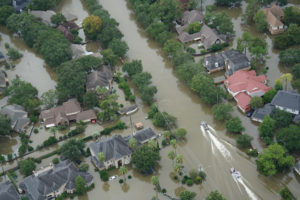By Insurance Buyers Council, Inc.
Since 1948, Insurance Buyers’ Council, Inc. (IBC) has a mission to provide their clients with unbiased information. IBC is not affiliated with companies that sell insurance to assure that the information they provide is completely unbiased; they do not benefit financially from any insurance recommendations. Combined, IBC’s staff possesses over 300 years’ worth of experience in the insurance and risk management industries.

Summary
Increasingly, floods are in the news. Flood coverage has become a topic of interest to many, given the severe flooding in Houston and the significant destruction across the Caribbean and Florida Peninsula in 2017 from Hurricanes Harvey, Irma and Maria. Floods are the nation’s most common and costly natural disaster and cause millions of dollars in damage every year. Floods can happen anywhere–more than 20 percent of flood claims come from properties outside the high-risk flood zone.i Architects are impacted by flood through exposures at their offices, their homes and their client’s properties.
The AIA Resilience and Adaptation Initiative aims to have members possess new awareness of emerging issues resulting from natural and human-caused hazards, climate change, the degradation of natural resources and population growth. This article provides information intended to help AIA members prepare to address a certain type of shock–that of a flood–in order to protect themselves and provide greater value to clients and communities.
Architects and their clients can reduce the impact of damage and business interruption from the peril of floods. An insurance policy covering floods is one tool.

Flood insurance
As learned by many Houston residents, most homeowners’ policies do not cover flood. Private homeowners’ policies generally cover wind damage and, in certain cases, water damage from storm surges.
The federal government provides flood insurance for a property through the National Flood Insurance Program (NFIP), run by the Federal Emergency Management Agency (FEMA). While they are underwritten by the government, NFIP policies are generally sold through private insurance agents. In some areas, primary flood insurance may be available through private insurers.
You may be required to have flood insurance. Congress has mandated federally regulated or insured lenders to require flood insurance on mortgaged properties that are located in areas at high risk of flooding. But even if your property is not in a high-risk flood area, your mortgage lender may still require you to have flood insurance.1
Flood zones
Flood maps, known as Flood Insurance Rate Maps (FIRMs), support NFIP and provide the basis for community floodplain management regulations and flood insurance requirements. The flood zone where a property is located will impact availability and pricing of insurance.
There are ‘special flood hazard areas’ and ‘moderate, minimal hazard areas’.
Information about flood maps can be obtained at the FEMA Flood Map Service Center (MSC). The MSC is the official public source for flood hazard information produced in support of NFIP.
NFIP insurance
There are three NFIP policy forms–the Dwelling Form, the General Property Form, and the Residential Condominium Building Association Policy Form. Selection of the applicable form to be used is dependent on the type of insurable property to be covered.
Flood, as used in the NFIP flood insurance policy, means:
1) A general and temporary condition of partial or complete inundation of two or more acres of normally dry land area or of two or more properties (one of which is your property) from:
- Overflow of inland or tidal waters;
- Unusual and rapid accumulation or runoff of surface waters from any source;
- Mudflow.
2) Collapse or subsidence of land along the shore of a lake or similar body of water as a result of erosion or undermining caused by waves or currents of water exceeding anticipated cyclical levels which result in a flood as defined in A.1.a. above.2 – October 2015 policy forms
There are some notable exclusions on the NFIP coverage form such as water, moisture, mildew and mold damage; business income; and back up of sewer or drains. View other sample NFIP forms.
The limits for the NFIP policy depends on which NFIP form applies. The Dwelling Form has Building limits up to $250,000 and personal property limits up to $100,000; and the General Property Form has Building limits up to $500,000 and business property limits up to $500,000.
When considering business properties, a major drawback of relying on the NFIP program is the lack of business interruption or extra expense coverage which should be considered.
Commercial flood insurance
Flood coverage can also be secured outside of the NFIP program. Coverage availability and limits depend on the location of the property (i.e. which flood zone) and the risk appetite of the insurer.
Many commercial insurers utilize Insurance Services Office Inc. (ISO) forms. All ISO causes of loss forms contain the same water exclusion, which eliminates coverage for loss from flood and several other types of water damage. However, ISO has a Commercial Property endorsement, the Flood Coverage Endorsement (CP 10 65), which is intended to “wrap around” a NFIP policy; applying on an excess basis over what is available under NFIP.3
NFIP policies do not provide any business income or extra expense coverage. Therefore, when this flood coverage endorsement is attached to a commercial property policy that provides business income or extra expense coverage, any covered business income or extra expense loss resulting from flood is payable after deduction of the flood coverage deductible amount shown in the declarations or flood coverage schedule.
Similarly, property valuation under an NFIP policy is at actual cash value; replacement cost coverage is not available. Therefore, if this endorsement is attached to a commercial property policy that provides replacement cost valuation, the difference between actual cash value and replacement cost would be covered under the flood coverage endorsement.3
As stated above, many commercial insurers utilize ISO forms. However, there are also other forms available in the marketplace and you can use the above ISO endorsement as a baseline for comparison.
Business interruption insurance
After a flood, there is not only physical damage to property but also income losses stemming from flooded and blocked roads and bridges, interruptions of shipping and air transport, evacuations, and closures by civil authority.
Business interruption (BI) insurance covers insured businesses for losses of income stemming from unavoidable disruptions to their regular operations as a result of damage to property. In addition to coverage resulting from damage to the policyholder’s own property, “BI” coverage also may be triggered by circumstances including utility service interruption, a government evacuation order, or a substantial impairment in access to a business’s premises.
Extra expense coverage applies to additional costs incurred by the policyholder as a result of damage to its property, and to costs incurred to mitigate economic losses.4
Assessing other coverage
Many commercial property insurance policies provide different sublimits for losses caused by “flood” “storm surge” and “named storms.” How the policy defines these key terms can be critical in determining the amount recoverable for the policyholder’s loss.4
In addition to flood damage, hurricanes can also cause wind damage. When reviewing your package/property policy, you should look for any wind coverage restrictions and any special sublimits and deductible provisions for this type of loss. This is important if your property or a client’s property is located in a moderate or a high wind area.
Another consideration is damage caused by mold which almost always follows a flood event. Mold is generally an excluded peril under property policies. Some property policy forms will cover mold if resulting from a covered peril like flood or windstorm. Such policies also include a provision that the insured is required to mitigate the damage by protecting the property against further damage. In other words, you must take reasonable steps to keep mold from spreading. You should assess your current package policy coverage to see what, if any, coverage for mold is available.
If you find coverage to be lacking or insufficient then the next step would be to work with your insurance agent to see if another insurance product is available to either replace, broaden or supplement your current program.
Conclusion
The recent hurricane season caused catastrophic damage, making 2017 one of the most expensive in history for natural disasters. AIA members must be aware of flood hazards in order to protect themselves and provide greater value to clients and communities. Flood limits and pricing will change considering the resulting flood events. In both their personal choices and in their work for clients, architects need to consider the risks presented by flood damage as this exposure becomes increasingly paramount in this new era of climate change.
References
- https://www.fema.gov/national-flood-insurance-program
- NFIP October 2015 policy forms – https://www.fema.gov/media-library-data/1503240146067-30b35cc754f462fe2c15d857519a71ec/16_policy_508_oct2017.pdf
- IRMI – https://www.irmi.com/online/cpi/ch006/1l06g000/al006915.aspx
- Understanding Post-Storm Business Interruption Coverage – article by Finley Harckham and Marshall Gilinsky posted for Risk Management Magazine dated November 6, 2017 –http://www.rmmagazine.com/2017/11/06/understanding-post-storm-business-interruption-coverage/
All information on this page is copyrighted by the AIA Trust and members of The American Institute of Architects may use the same with permission. The authors and the AIA Trust assume no liability for the use of this information by AIA members or by others who by clicking on any of the links above agree to use the same at their sole risk. Any reproduction or use is strictly prohibited.
This information is provided as a member service and neither the Author nor the AIA Trust is rendering legal advice. Laws vary by state and member should seek legal counsel or professional advice to evaluate these suggestions and to advise the member on proper risk management tools for each project.